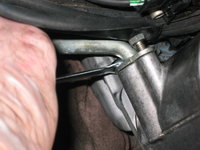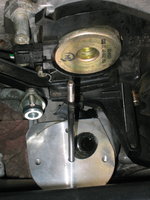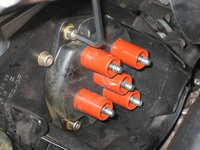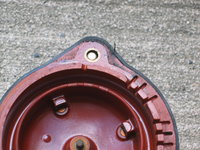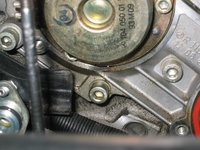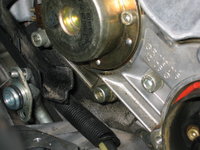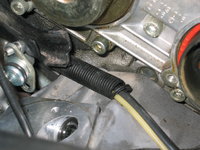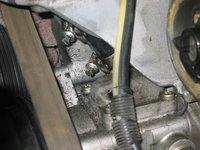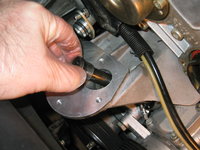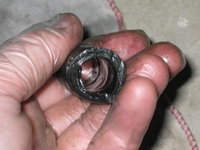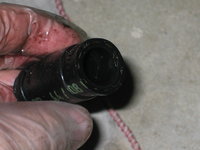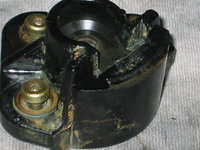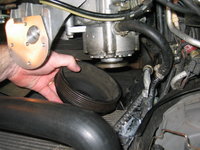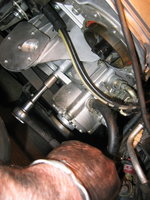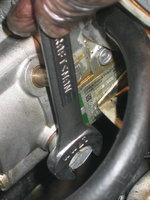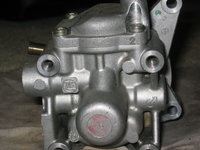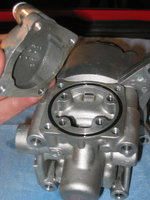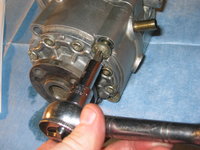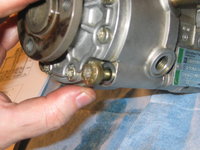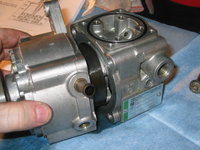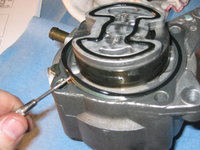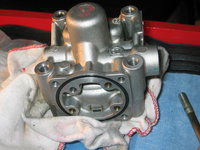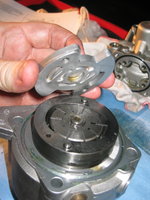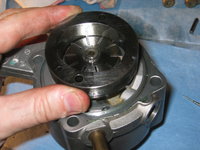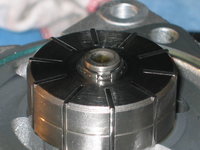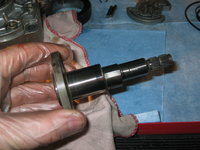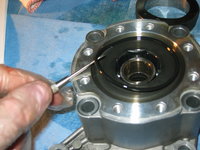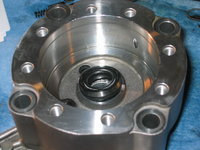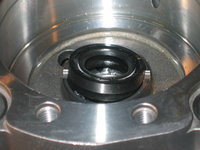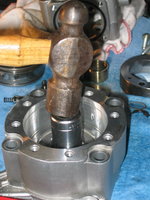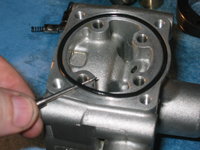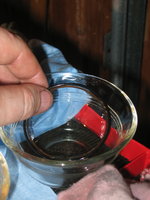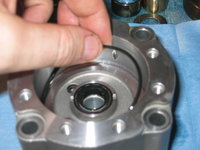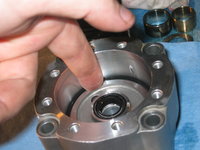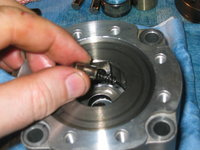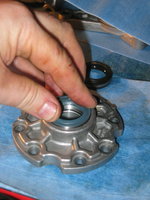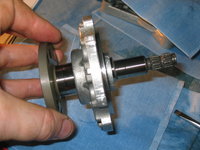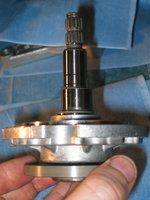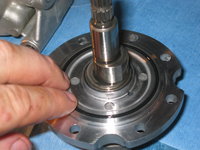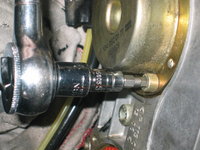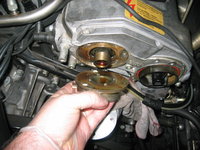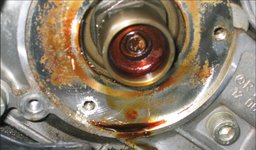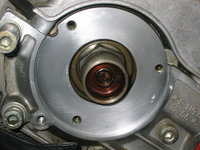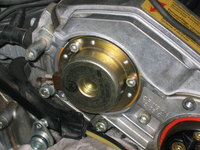ADMIN EDIT: I cleaved off the power steering posts from my thread on the transmission upshift issue, and created this new thread.
GSXR EDIT: Merged related threads (see post #119), re-named thread.
NOTE: If you are leaking power steering fluid, most likely you DO NOT need to remove, re-seal, or rebuild the tandem pump. If you are leaking SLS fluid and the hoses are all dry, you most likely will need to remove and re-seal / replace the tandem pump.
I was losing about a drop an hour of transmission fluid on the floor of my garage, since I changed the fluid and filter. After taking things out yesterday for a run, to be sure they were working OK, it was time to tackle the minor leak. So today I got under the car with a torch and checked to see where the leak was coming from. It was at the drain plug.
I had re-used the original drain plug (which had shown some signs of minor stripping of the 5mm hex socket from past oil changes) and washer, and it was probably the re-used washer that was causing the problem. Luckily, I'd ordered two brand-new drain plugs and four copper drain-plug washers for the transmission pan, on my parts order from AHAZ. So, I put my catch basin under the transmission pan, readied the new drain plug with copper washer, loosened the old one with one hand and immediately installed the new one with the other hand. Minimal fluid lost, and all done in less than a minute after tightening things up.
No leakage since. A careful inspection of the pan gasket around the perimeter of the pan showed no leaks whatsoever, indicating a good seal job at the pan.
So, I will consider this job done. I took some brake cleaner and cleaned around the power steering pump from up above. It appears that the pump itself is leaking, not the hoses. So, that means the pump has to come off and get re-sealed. Just the right time of year here in Texas to do this. That's my next job on the E500, and the next one after that will be to install new upper strut mounts, and the RDMTek rear lower control arms, and new upper strut rubber bushings. Oh yeah, and my 1-bump spring pads all around....
Cheers,
Gerry
========================

On Doug's advice, I headed out to the garage to do a little further (and closer) investigation on my leaking tandem pump assembly. Had a couple of goals ...
1) to confirm what type of pump I actually do have
2) to check closer, to see if the source of the leak could be determined
I may well have answers now, to both questions.
It actually appears as if it may well be the short hose between the reservoir and the pump body itself.
And, my pump is very definitely a ZF model, NOT a Vickers/LUK model. I was able to clearly see the green and silver plate on the outside of the pump with the ZF logo and the word "Zundfabrik," which tells me all I need to know.
A thorough investigation of the high-pressure hoses indicated that they did NOT seem to be wet (I had not cleaned them with brake cleaner over the weekend, just the pump, pulley and under-reservoir area itself). After removing my intake tube and the black plastic distributor cap cover, I was able to see things just a bit better, and could see that there was some wetness around the short hose piece joining the pump and the reservoir. Sticking my fingers in this area confirmed this -- they came out very wet.
You can see the one sort of cloudy photo that has the best close-up I could get of the short-hose area under the reservoir. You can see that it's quite wet and gritty in there....
You can see photos from my investigation, attached below. Sorry about the quality -- hard to get a pinpoint focus on things with a 10-year-old Canon PowerShot S45. But you get the idea. You can see the areas under the reservoir that cleaned up quite nicely with the brake cleaner. From what I can see, there was no seepage after driving the car ~15 miles yesterday, or just standing over night.
After already compiling a dossier/folder of information pertaining to a pump removal and rebuild .. it is looking quite possible that I may escape from this one with just a reservoir removal and hose replacement. I guess I'll know more once I get into this job and get into it layer by layer.
First things first - need to drive the car a couple or three hundred miles to see if I can get it to leak some more PS juice.
Cheers,
Gerry
GSXR EDIT: Merged related threads (see post #119), re-named thread.
NOTE: If you are leaking power steering fluid, most likely you DO NOT need to remove, re-seal, or rebuild the tandem pump. If you are leaking SLS fluid and the hoses are all dry, you most likely will need to remove and re-seal / replace the tandem pump.
I was losing about a drop an hour of transmission fluid on the floor of my garage, since I changed the fluid and filter. After taking things out yesterday for a run, to be sure they were working OK, it was time to tackle the minor leak. So today I got under the car with a torch and checked to see where the leak was coming from. It was at the drain plug.
I had re-used the original drain plug (which had shown some signs of minor stripping of the 5mm hex socket from past oil changes) and washer, and it was probably the re-used washer that was causing the problem. Luckily, I'd ordered two brand-new drain plugs and four copper drain-plug washers for the transmission pan, on my parts order from AHAZ. So, I put my catch basin under the transmission pan, readied the new drain plug with copper washer, loosened the old one with one hand and immediately installed the new one with the other hand. Minimal fluid lost, and all done in less than a minute after tightening things up.
No leakage since. A careful inspection of the pan gasket around the perimeter of the pan showed no leaks whatsoever, indicating a good seal job at the pan.
So, I will consider this job done. I took some brake cleaner and cleaned around the power steering pump from up above. It appears that the pump itself is leaking, not the hoses. So, that means the pump has to come off and get re-sealed. Just the right time of year here in Texas to do this. That's my next job on the E500, and the next one after that will be to install new upper strut mounts, and the RDMTek rear lower control arms, and new upper strut rubber bushings. Oh yeah, and my 1-bump spring pads all around....
Cheers,
Gerry
========================

Hi Gerry,
Are you certain it isn't the feed hose from the power steering reservoir to the pump? Mine was leaking (and it is a very common leak) and is now fixed. Reach down below the reservoir and see if that short hose is wet. You can barely see the hose clamps if you look closely from the top with a flashlight above the pulley which drives the tandem pump.
Much simpler job than removing and resealing the pump.
I can send you some of the hose if you don't have it. Dealer wants to sell you a meter when you need 2".
When I assembled mine, I dropped 4 new clamps onto the new hose, so I could double clamp if it started to leak.
Doug
On Doug's advice, I headed out to the garage to do a little further (and closer) investigation on my leaking tandem pump assembly. Had a couple of goals ...
1) to confirm what type of pump I actually do have
2) to check closer, to see if the source of the leak could be determined
I may well have answers now, to both questions.
It actually appears as if it may well be the short hose between the reservoir and the pump body itself.
And, my pump is very definitely a ZF model, NOT a Vickers/LUK model. I was able to clearly see the green and silver plate on the outside of the pump with the ZF logo and the word "Zundfabrik," which tells me all I need to know.
A thorough investigation of the high-pressure hoses indicated that they did NOT seem to be wet (I had not cleaned them with brake cleaner over the weekend, just the pump, pulley and under-reservoir area itself). After removing my intake tube and the black plastic distributor cap cover, I was able to see things just a bit better, and could see that there was some wetness around the short hose piece joining the pump and the reservoir. Sticking my fingers in this area confirmed this -- they came out very wet.
You can see the one sort of cloudy photo that has the best close-up I could get of the short-hose area under the reservoir. You can see that it's quite wet and gritty in there....
You can see photos from my investigation, attached below. Sorry about the quality -- hard to get a pinpoint focus on things with a 10-year-old Canon PowerShot S45. But you get the idea. You can see the areas under the reservoir that cleaned up quite nicely with the brake cleaner. From what I can see, there was no seepage after driving the car ~15 miles yesterday, or just standing over night.
After already compiling a dossier/folder of information pertaining to a pump removal and rebuild .. it is looking quite possible that I may escape from this one with just a reservoir removal and hose replacement. I guess I'll know more once I get into this job and get into it layer by layer.
First things first - need to drive the car a couple or three hundred miles to see if I can get it to leak some more PS juice.
Cheers,
Gerry
Attachments
-
 IMG_2002.jpg466.6 KB · Views: 282
IMG_2002.jpg466.6 KB · Views: 282 -
 IMG_2013.JPG272.6 KB · Views: 194
IMG_2013.JPG272.6 KB · Views: 194 -
 IMG_2012.JPG289 KB · Views: 192
IMG_2012.JPG289 KB · Views: 192 -
 IMG_2011.JPG364.2 KB · Views: 202
IMG_2011.JPG364.2 KB · Views: 202 -
 IMG_2010.JPG291.9 KB · Views: 199
IMG_2010.JPG291.9 KB · Views: 199 -
 IMG_2009.JPG631.6 KB · Views: 205
IMG_2009.JPG631.6 KB · Views: 205 -
 IMG_2008.jpg352.6 KB · Views: 209
IMG_2008.jpg352.6 KB · Views: 209 -
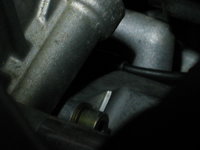 IMG_2007.JPG276.6 KB · Views: 207
IMG_2007.JPG276.6 KB · Views: 207 -
 IMG_2004.JPG438.9 KB · Views: 232
IMG_2004.JPG438.9 KB · Views: 232 -
 IMG_2003.jpg500.9 KB · Views: 247
IMG_2003.jpg500.9 KB · Views: 247 -
 IMG_2014.JPG282 KB · Views: 200
IMG_2014.JPG282 KB · Views: 200































